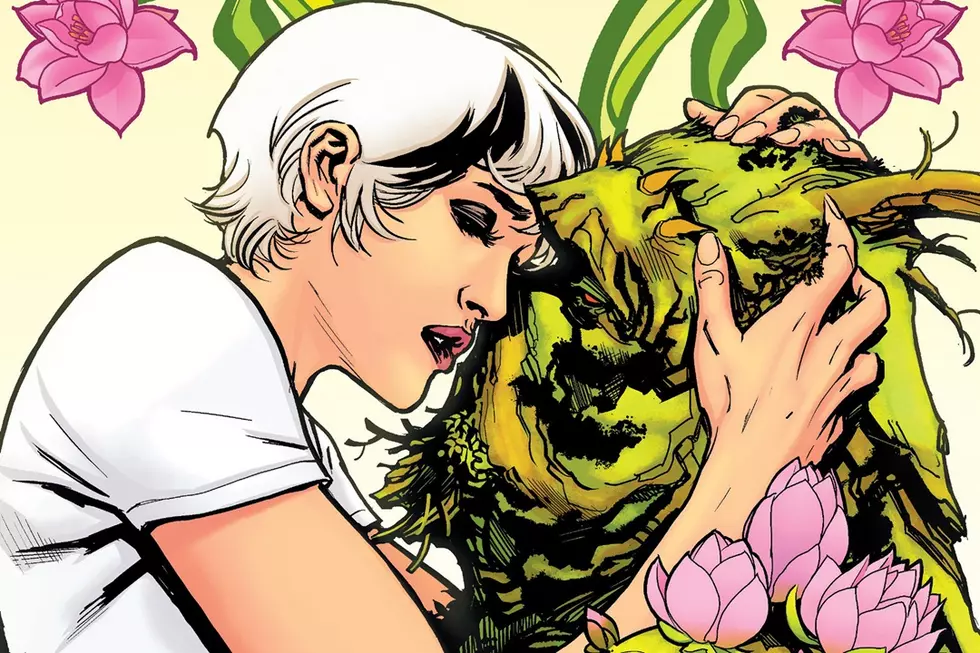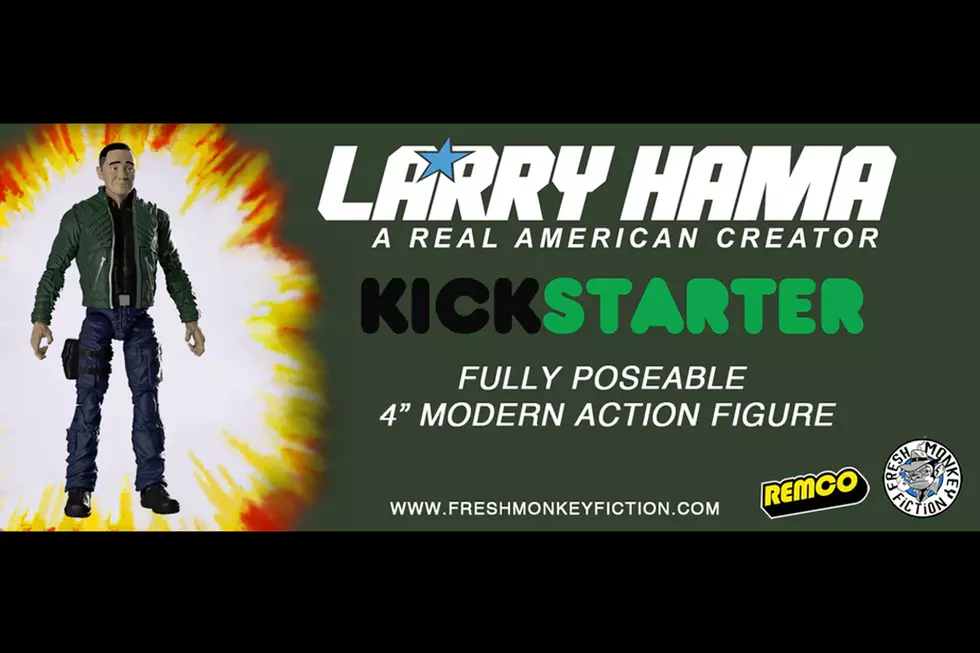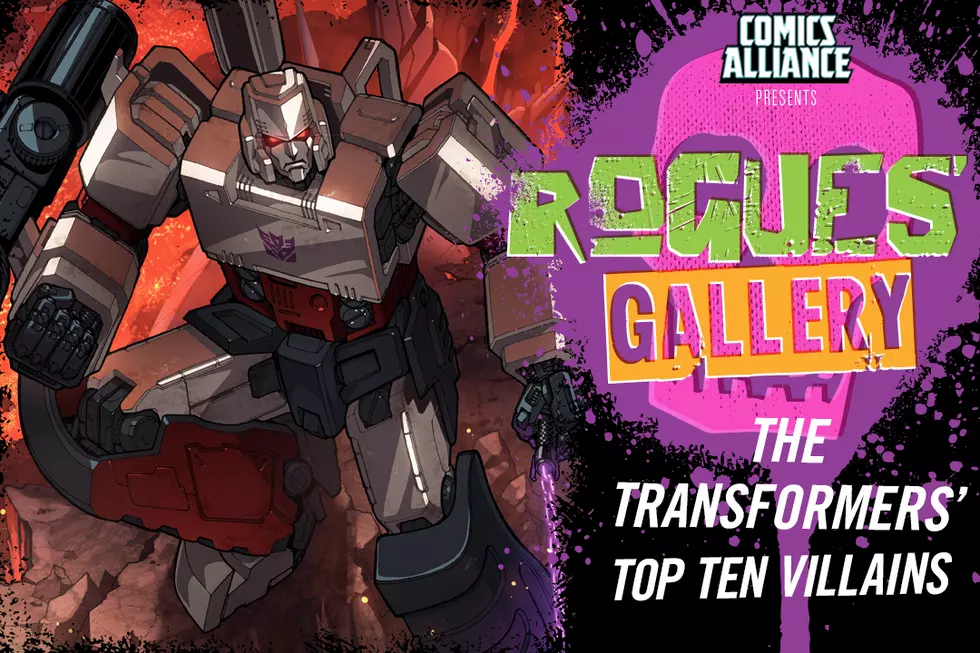![Escalation: Tom Scioli And John Barber On ‘Transformers vs. G.I. Joe’ Volume 1 [Interview]](http://townsquare.media/site/622/files/2014/12/TFJ00-630x420.jpg?w=980&q=75)
Escalation: Tom Scioli And John Barber On ‘Transformers vs. G.I. Joe’ Volume 1 [Interview]
If you asked me to pick my favorite comics of the year, there's not even a question about it: Transformers vs. G.I. Joe would be at the top of the list. Even aside from my well-known love of America's daring, highly-trained special missions force, writer/artist Tom Scioli and co-writer John Barber have been doing something amazing with this book, creating an ongoing series combining two toy franchises that has the kind of raw, unstoppable energy that you almost never see from corporate comics.
Now, with the first volume of the series hitting shelves this week, I spoke to Scioli and Barber about how they created one of the most transgressive comics of the year, why they think of the Joes as "nasty, destructive creatures," and just how much more they want to push the book until it's as strange as they want it to be.
ComicsAlliance: The amazing thing about Transformers vs. G.I. Joe for me as a reader is that it doesn't feel like it should exist, and I mean that in the best way possible. It has this feeling that there's no way this book should've been approved, because it's so wild, raw and energetic. How did you get that feeling to come across in this comic?
Tom Scioli: I don't know how you would get to that point with any kind of comic. Just from my perspective, I've been doing comics for such a long time and in such a way that's very different from the normal career path for comics, so I don't know how you replicate that. I don't know how many other people are out there that would be able to have that mix of discipline and self-destructive chaotic impulse to get that. I don't know, John? Do you have any perspective?
John Barber: To one degree or another, when you're working on something that's company-owned, you have to forget about that when you're working on it, and I think that degree varies. The whole idea was to make something kind of weird, that went out the window at some point. There was probably a minute early on where Michael Kelly, the guy we work with at Hasbro as their Director of Global Publishing, called and he was like, "This isn't exactly what we talked about." He loves the book, but at some point, the idea was going to be safer. It's not like there's anything unsafe about this, either, but you want to be able to point at it and say "here are these two things that we put together to make one thing," and I don't think you can do that with our book. I think that's what makes it interesting.
TS: I didn't really know how it was going to turn out either. It's a project where it's like "yeah, what would this thing be?" I know that when we first talked about in the beginning, we had that very basic idea of a Jack Kirby take on this sort of thing, but when you sit down to actually make it, all these other opportunities open up. All these other creative things take over, and it outgrows that initial idea. But then it sort of comes back to it. Early on, I thought I wanted to do something more serious than just a straight Jack Kirby rip-roaring adventure, but then it turned into that kind of rip-roaring adventure.
CA: There are scenes in this book, and I'm specifically thinking about that page where Dr. Venom shoots Buzzer in the head, and it's the kind of thing where it's shocking. Not just because I haven't seen it in Transformers or G.I. Joe comics in the past, but because I would never expect that to be there in a licensed comic. Even the original Larry Hama Joe book, which I'm a huge fan of, always felt like a licensed comic. Yours, though, feels weird and original, even though it's got these characters I've known for almost 30 years.
TS: There's so many ways you can approach any existing thing, whether it's something like Batman or something like this, where there are ways you can imagine, "I can have this happen, I can have that happen," and you can predict it. That means that it's probably not an original idea. But if you're coming up with something and you're surprising yourself with it, and you're doing things with characters where you don't even think these characters were intended to be used this way, that's how you know you're onto something. That's how you know you're creating something, as opposed to dressing up something old in new clothing.
CA: John, you mentioned the idea of the book changing from when you first started. I know that we talked before about Tom coming in with this huge pitch document when it started. How much did the first four issues change from the original pitch to what exists now?
JB: A lot? Not a lot? I don't know. [Laughs] Bits and pieces are the same, but a lot of it's pretty different. Every step along the way is really different, if that makes any sense. The pages coming in from Tom are frequently pretty different by the time they're finished than when he's done layouts. It stays very, very fresh. Clearly, it's very surprising. What you said about surprising yourself is what you're doing, right?
TS: I think about how a lot of these people approach comedy movies, where they're developing the material up until the very last second. They have a script, but then as they're filming, they'll try to improvise. In the Iron Man movie, they talked about that, approaching it that way. For me, until this thing is uploaded, it's all fluid. It could be anything. If there's a last-minute inspiration that happens, I can let it happen. Pursuant to your question, I almost think of this series as though there's a serious, straight version of this story that we thought was going to happen, but it never did, and our book is a postmodern remix and retelling of this straight story that just doesn't exist.
JB: You talk about comedy films doing that, and it makes a lot of sense. There's a lot of stuff that does that. You ever watch, like, a Subway commercial, and it has the cadence of a joke, but there actually isn't a joke built into it? I think a lot of movies come out like that, and a lot of comic books that try to do something interesting like that come out really hollow in that same way. You figure out the rhythms of a joke, so you'll try to structure the story that way. I'm not saying Transformers vs. G.I. Joe is a joke, but taking a similar approach to comedy and trying to pull it apart, that's what Transformers vs. G.I. Joe is.
TS: Approaching any story is kind of like that. With the scriptwriting phase, I thought we'd have to lay a lot more track to get to where we were going to get to, but once you sit down and start making the comic, you put a drawing down and all the sudden, all that stuff that I thought was going to take pages and pages to describe just happens instantly, so you can move ahead. We've gotten so far ahead of the agenda that we set out that we're in a lot of uncharted territory.
CA: I'm just going to put down that the biggest influence on this comic is your love of Subway commercials.
JB: [Laughs] That's right. It's my biggest influence on anything. I'm always saying "Can we Subway this up a little bit more?"

CA: Along those same lines, I'm a much bigger fan of Joe than Transformers, so most of the Transformers comics that I've read have been crossovers with G.I. Joe, and I don't think I've ever seen one that was structured like this, with the Joes going to Cybertron. Was that just an obvious thing that you'd never seen?
JB: That was there from the beginning. 100% of this comic is Tom at this point, and I don't know what I'm doing anymore. I expect that one day, Tom will just stop emailing me.
TS: [Laughs] I'll just send you the finish comic.
JB: Right. But every other Transformers/G.I. Joe comic, at least every one that I read, tried to drag Transformers to a realistic level and throw that into the G.I. Joe world. I thought the idea of blowing up G.I. Joe and making them science-fiction, having them live in the Transformers' world, was there. If anything, Cybertron was the one thing I really wanted to do. But it obviously came out much cooler in the comic than I would've thought of.
CA: You have these pieces of G.I. Joe that really serious G.I. Joe fans never want to talk about. Nobody wants to talk about Star Brigade or Ninja Force, but this is a comic that not only embraces those ideas, but says "Oh, we should also make the Oktober Guard Halloween-themed."
JB: I loved that. That was all Tom. But yeah, G.I. Joe was like that from day one. The first time I saw G.I. Joe was at this toy store called Dispensa's Kiddie Kingdom in Illinois, it was shaped like a castle with rides in back. I remember going there with my dad and seeing the G.I. Joe toys for the first time. I'd never heard of the earlier versions, I was like six years old. You had the guys with the machine guns, and then you had Scarlett, who's basically wearing a superhero costume with a crossbow, you had Flash, who's a laser trooper, you have laser cannons and jetpacks. From day one, it's an amalgamation of the real world Vietnam stuff that Larry came back with, plus this crazy M.A.R.S. Patrol sci-fi military. As the toys went on, it went both ways, they got more realistic and more crazy at the same time.
TS: Right.
JB: At a certain point, it's just all muddiness, but you had these science fiction land-cruiser vehicles teamed up with really realistic transport helicopters. It's always there.
CA: Has there been a moment where you've been satisfied with how far you've pushed it? Every time a new issues comes out, it seems like you're trying to get bigger, weirder, more violent and more over-the-top. Is there a moment where you think "This is exactly the level we need to be at."
TS: That one you mentioned with Dr. Venom shooting Buzzer, that was one of the moments I was very proud of in the way that you described.
CA: I had to put down the comic after that page and call someone to talk about it.
JB: [Laughs]
TS: The most recent issue that came out, #4, has one crazy thing after another. The Oktober Guard thing, the super-pets. It just escalates.

CA: Bazooka tripping on Cybertronian plants.
TS: Yeah, you're right.
JB: They've all had a different feel to them. I've always felt like each one maybe hasn't been getting crazier -- #4, like you said is the craziest one and has a bunch of stuff that's really nuts -- but all the other ones have their own feel. You said that from the beginning, that every issue is its own movie.
TS: Yeah, that's the biggest challenge. I want each one to be like its own graphic novel, its own individual statement, and that's really hard. So much of serial comics and serial writing in general, you have a few beats and then you deliver on one or two things and push everything off into the future. You push everything off, and then in a lot of cases that stuff never gets addressed. There are direction changes, books get canceled. To me, I want each book to be as complete as I can possibly make it. That's the big challenge of it.
CA: How does that affect how you work on a structural level? You have these big, elaborate splash pages, but then you go into these hyper-detailed eleven- or twelve-panel pages where your'e using insets and cutaways and cramming everything as full as you can. Does that affect how you approach the story differently than, say, American Barbarian or Final Frontier?
TS: Those books didn't have a rigid format. The comic book format is a rigid format. It's 20 pages. It's 20 pages no matter what, and that 20 pages has to be in it. I have 20 pages, and I have to make each one not just count, but be the best possible way of communicating whatever that moment is. It's a ton of pressure. Is there a better version of this page? Is there a better version of this moment? That's why the approach changes so much from page to page.
CA: Is there a moment that you've done in the book that you're especially proud of, that you'd show to someone to show them exactly what your book is about?
JB: Destro walking through that M.AS.S. Device and having a conversation with Megatron's gun. That's a hell of a scene.
TS: I think #2 was the first time that it occurred to me that you can really tell it from the Transformers perspective, every bit as much as the G.I. Joe. We had initially thought of it as the Transformers being this big thing that G.I. Joe had to contend with, but then we realized each one could have its point of view. I'd point to the moment where there's a madcap chase element to it, where the Joes land and they're running from the Decepticons, and at the same time, some Autobots are being chased by those same Decepticons, and they all get caught in this trap together. There are these two parallel chases going on, and everybody's confused about who everybody else is. The Joes, because they're little, can slip through the cracks in the trap, but they're much more vulnerable than the stronger Transformers. There's a two-page sequence of that, where the road itself folds itself into a trap. That's feels like where it really crystalized everything. Having as much narrative content going on in two pages as we can, and having it read seamlessly. I feel like there's a really good flow in that sequence.
CA: As someone who was never a big Transformers fan, the way you present their side of this story is really interesting to me. It's this epic, thousand-year war among these creatures that are so huge and strange and unknowable. It's like they're Lovecraftian monsters, if Lovecraft was writing about robots that turned into cars. That's really intriguing.
TS: We flip-flop that, too, going back and forth. They're this mysterious Other, but then one page later, they're talking in a vernacular and acting very humanized, and then switching back again. I don't know if it's just something about comics itself, but as a reader, you're able to change gears like that, so fast. I don't know that anybody's really tested a reader's ability to change gears the way we have.
JB: Yeah, that scene with Rodimus and Blaster at the Smelting Pool, that becomes really relatable Transformers stuff. It's an epic space war, but you can feel where those guys came from. They betrayed themselves and each other.
TS: That was a surprisingly emotionally resonant moment. What occurs to me is that a lot of the most human moments in this story are with the Transformers. The Joes are, in a lot of ways, these nasty little creatures of destruction. The Transformers are the more well-rounded emotional creatures.
CA: I'm curious about the response from fans.
TS: It depends on what you mean by "fan." There's comics fans, there's Transformers fans, there's G.I. Joe fans, there's fans of pop entertainment...
CA: That's what I wanted to ask. Have you heard from anyone who isn't a fan of Transformers or G.I. Joe, but is a fan of art comics or the world outside of what we think of those two franchises occupying?
TS: That's what I was targeting, everybody but the sort of person who's read a Transformers or G.I. Joe comic before, and I've heard from a lot of them. It's been awesome. I hear so many times from people, "I never would've thought of picking up a Transformers or G.I. Joe comic, and now this is my favorite comic." What you said about art comics, that's sort of the realm I live in to a degree. I do a lot of those shows, and I feel like that's where I come from, and the response there has been incredible. It's been embraced as an art comic, as strange as that sounds.
CA: It's one of those rare comics that can succeed in those places. I wouldn't really compare it to what Larry Hama and S.L. Gallant are doing in G.I. Joe as much as I'd compare it to Ed Piskor or Jim Rugg.
JB: That's one of the things that's really cool about it. You definitely see people who would never read a mainstream Transformers or G.I. Joe comic falling in love with it, and you also see people that only read Transformers or G.I. Joe loving this. It's really crazy to have a comic like that. My whole professional career has been in mainstream comics, but my background and the stuff I grew up reading and was looking at my whole life wasn't necessarily mainstream stuff. It's really rare that you get something that not only hits both of those points, but fulfills the promise of both of those points. You wouldn't want to pull Chris Ware out and have him do an X-Men comic. If you want to read X-Men, that's not the part of your brain that you're engaging when you read Chris Ware. But this somehow hits both.
TS: It's so hard to be transgressive nowadays, because what are the structures? People don't bow before a single church or anything, so what's transgressive? This book is automatically transgressive just by virtue of being corporate licensed properties. The sanctity of a brand is the last holy space.
JB: [Laughs] It sort of is.
TS: We've created something transgressive in a time when that's very hard to do.
Transformers Vs. G.I. Joe Volume 1 goes on sale this week from IDW Publishing.
More From ComicsAlliance

![The Dreadnoks Are Back At It Again In ‘GI Joe’ #3 [Preview]](http://townsquare.media/site/622/files/2017/03/GIJoe00.jpg?w=980&q=75)


![Unsinkable Ship: The 100% Logical, Provable Case for ‘Lost Light’s’ Nautica/Velocity [Love & Sex Week]](http://townsquare.media/site/622/files/2017/02/nautica-velocity-feature.png?w=980&q=75)




